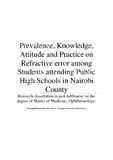| dc.contributor.author | Nyamai, Lily A | |
| dc.date.accessioned | 2016-04-27T06:47:15Z | |
| dc.date.available | 2016-04-27T06:47:15Z | |
| dc.date.issued | 2015 | |
| dc.identifier.uri | http://hdl.handle.net/11295/95106 | |
| dc.description.abstract | BACKGROUND: Uncorrected refractive error is a major public health concern and is the biggest cause of visual impairment in the world. Refractive errors can be easily corrected with spectacles. Lack of knowledge, erroneous attitude and practices, contribute significantly to the magnitude of uncorrected refractive errors.
PURPOSE: The objective this study was to assess the prevalence and type of refractive error in urban public high school students as well as their knowledge, practice and attitude towards refractive errors.
METHODS:
Study Design and Study Population: Cross sectional school based study with a qualitative component in at least 1297 public high school students of Nairobi County, Kenya.
Data collection Procedure: The schools were selected by multistage random sampling and the students included in each school category were based on proportion of students in each stratification. All Form 3 students in the selected schools participated in the study. First, a semi structured KAP questionnaire was administered to the students followed by an eye examination that consisted of visual acuity using a Log MAR chart. The cut off for defining significant refractive error was VA less than 6/12 in the better eye. For those whose vision was less than 6/12 in the better eye a dry objective refraction was performed followed by subjective refraction. Students with spectacles were tested for uncorrected and corrected VA. The power of spectacles was read using the lensometer. For those wearing spectacles and VA worse than 6/12 in the better eye with correction, objective then subjection refraction was done. If VA did not improve by at least two lines in all students anterior and posterior examination was performed to determine the cause. The students then participated in Focus
12
Group Discussion of 8-12 students and in-depth interviews with key informants (class or head teacher). The information gathered was recorded in a questionnaire or a tape recorder.
Data Analysis: The data was analysed using SPSS 20.0.Graphs, tables and charts were used to analyse means and proportions. Chi-square test was used compare means and proportions.
Results: The prevalence of significant R.E was found to be 17.2%. The prevalence of myopia, hyperopia and astigmatism was 15.6%, 0.9% and 7.6% respectively. The proportion of students with uncorrected refractive error was 64.1%. Only 39% of students had an eye exam prior to this study. Cost (38%) and fear of being teased (38.1%) were the most common reasons for not wearing spectacles amongst students. Mixed attitudes as regards spectacles preventing normalization of eyes and spectacles leading to dependence and worsening of vision were elicited. Most students (72.3%) of students with spectacles preferred another way of correcting their poor vision and 69.1% of these preferred contact lenses. | en_US |
| dc.language.iso | en | en_US |
| dc.publisher | University of Nairobi | en_US |
| dc.rights | Attribution-NonCommercial-NoDerivs 3.0 United States | * |
| dc.rights.uri | http://creativecommons.org/licenses/by-nc-nd/3.0/us/ | * |
| dc.title | Prevalence, knowledge, attitude and practice on refractive error among students attending Public high schools in Nairobi County | en_US |
| dc.type | Thesis | en_US |
| dc.description.department | a
Department of Psychiatry, University of Nairobi, ; bDepartment of Mental Health, School of Medicine,
Moi University, Eldoret, Kenya | |



